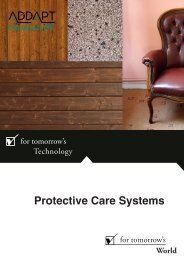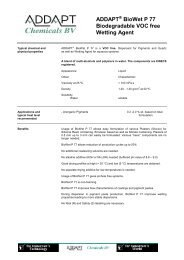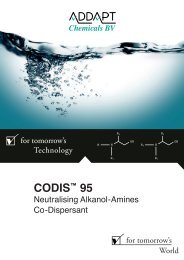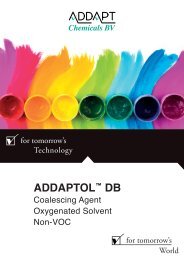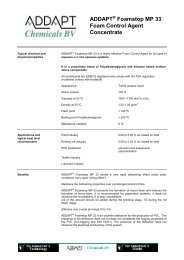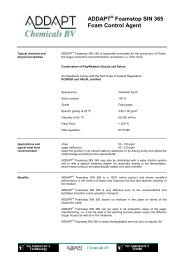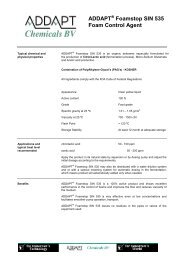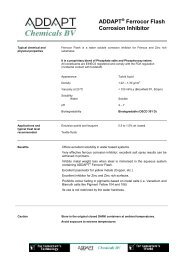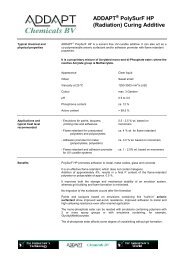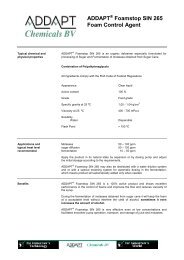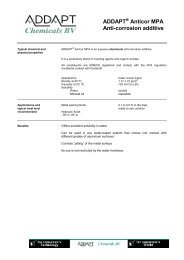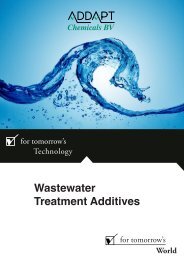Contents
PolySurF - ADD APT Chemicals
PolySurF - ADD APT Chemicals
- No tags were found...
Create successful ePaper yourself
Turn your PDF publications into a flip-book with our unique Google optimized e-Paper software.
1. IntroductionThere is an increasing demand for the development and use of environmentalfriendlier raw materials and products due to legislation and, ever so important:customer demand.The composition and use of solvent based products such as paint, adhesives andprinting inks has already changed dramatically but need further changes in comingyears. The demand for new, environmental friendlier systems is therefore strongerthan ever, not only based on ecological reasons but also due to increasing qualitydemand.It has been shown that a solution for both problems is possible: new water basedsystems having low or no emission of volatile materials showing performancematching the classic solvent based systems. Main part of this success can beattributed to a new generation of additives allowing more formulation freedom.ADDAPT Chemicals offers, amongst other, a new generation of functionalmonomers/additives for use in emulsion polymerisation or use as additives inUV/EB-curable systems.This brochure gives an overview of the ADDAPT ® PolySurF products for useas adhesion promoters, polymerisable stabilisers, polymerisable plasticizer andpolymerisable wetting agents.4
2. Properties2.1 ADDAPT ® PolySurF HP R=HOO|| ||CH 2= C – C – O - - O - P - OR| |CH 3OR= Hydrophobic groupAv. Molecular Weight: 250Suggested applications:• Radiation Curable systems.• Co-monomer in Poly Acrylic Pigment Dispersants.• Polymerisable Stabiliser for Emulsion Polymerisation Processes.• Suggested end-use:Paints & Coatings (primers; wet-scrub improvement of emulsions etc.)Adhesives & Bonding AgentsPigment DispersantsPrinted Circuit Board (PCB) – Solder Masks & Etch resist filmPhotographic FilmDetergents & CleanersRadiation Curable Metal primers and finishesSuperabsorbentsProduct benefits:• Excellent Mechanical Stability – Non Migratory (Emulsion Polymerisation).• Excellent Polyvalent cation tolerance (Ca 2+ etc.).• Improved properties over (Meth)acrylic acid in Emulsion Polymerisation.• Highly reactive – good compatibility with Acrylic and Methacrylic esters.• Excellent Adhesion Promoter to all metal substrates, metal-oxides, glass, ceramics andconcrete.• Imparts very good corrosion inhibiting properties after polymerisation.• Gives flame retardant properties due to the Phosphor content.Note: ADDAPT ® PolySurF HP is not a surfactant and as such has no HLB-value.Typical chemical and physical characteristics:AppearanceClear liquidOdourSweet smellViscosity at 25 ºC 1250 - 3500 mm 2 /s (cSt)Colourmax. 4 GardnerpH 0.5 to 3.0Phosphore content ca. 12%Active content > 99.5%5
2.2 ADDAPT ® PolySurF HPH R = - (CH 2CH 2O) 10OO|| ||CH 2= C – C – O - - O - P - OR| |CH 3OR= Hydrophobic groupSuggested applications:• Radiation Curable systems.• Co-monomer in Poly Acrylic Pigment Dispersants.• Polymerisable Stabiliser for Emulsion Polymerisation Processes.• Suggested end-use:Paints & Coatings (Wood finishes; Metal coatings; Mirror Backing Films)Adhesives & Bonding AgentsPigment DispersantsPrinted Circuit Board (PCB) – Solder Masks & Etch resist filmPhotographic FilmDetergents & CleanersRadiation Curable Metal primers and Wood finishesProduct benefits:• Excellent Mechanical Stability – Non Migratory (Emulsion Polymerisation).• Excellent Polyvalent cation tolerance (Ca 2+ etc.).• Improved properties over (Meth)acrylic acid in Emulsion Polymerisation.• Highly reactive – good compatibility with Acrylic and Methacrylic esters.• Very Good Adhesion Promoter to all metal substrates.• Imparts very good corrosion inhibiting properties after polymerisation.• Improves wetting on metal and wood substrates in Radiation Curable Systems.Note: ADDAPT ® PolySurF HPH is not a surfactant and as such has no HLB-value.Typical chemical and physical characteristics:AppearanceClear liquidOdourSweet smellViscosity at 25 ºC < 350 mm 2 /s (cSt)Colourmax. 2 GardnerpH < 3.0Phosphorus content ca. 6.5%Active content > 99.5%6
2.3 ADDAPT ® PolySurF HPL R = - (CH 2) 10-12OO|| ||CH 2= C – C – O - - O - P - OR| |CH 3OR= Hydrophobic groupSuggested applications:• Radiation Curable systems• Co-monomer in Poly Acrylic Pigment Dispersants• Polymerisable Stabiliser for Emulsion Polymerisation Processes• Suggested end-use:Paints & CoatingsAdhesives & Bonding AgentsPrinted Circuit Board (PCB) – Solder Masks & Etch resist filmPhotographic FilmRadiation Curable Metal primers and finishesProduct benefits:• Excellent Non Migratory Plasticizer• Highly reactive – good compatibility with Acrylic and Methacrylic esters• Very good Adhesion Promoter to all metal substrates• Very good Corrosion Inhibitor for Metal pastes (Bronze and Aluminium pastes)• Imparts very good corrosion inhibiting properties after polymerisation.Typical chemical and physical characteristics:AppearanceClear liquidOdourSweet smellViscosity at 25 ºC 50 - 300 mm 2 /s (cSt)Colourmax. 2 GardnerpH 0.5 to 2.0Phosphorus content ca. 10%Active content > 99.5%7
2.4 ADDAPT ® PolySurF ACEOOH|| |CH 2= CH – C – O - CH 2– CH – Versatic AcidSuggested applications:• Radiation Curable systems.• Co-monomer in Poly Acrylic Pigment Dispersants.• Co-monomer for Emulsion Polymerisation Processes.• Suggested end-use:Paints & Coatings (Wood finishes, Automotive finishes)Adhesives & Bonding AgentsPigment DispersantsPrinted Circuit Board (PCB) – Solder Masks & Etch Resist filmRadiation Curable finishesProduct benefits:• Polymerisable Monomer with excellent pigment wetting properties.• ADDAPT® PolySurF ACE improves adhesion to Polyolefin’s, Polyethylene Therephtalateand Polyvinylchloride.• Imparts Hydrophobic properties in Emulsions.• Highly reactive – good compatibility with VEOVA, Styrene, Acrylic,and Methacrylic esters.• Good Acid resistance.• Contains a reactive sec. OH-group for improved intercoat adhesion.• Imparts good UV stability in resins after polymerisation.Typical chemical and physical characteristics:AppearanceClear liquidOdourAcidic smellViscosity at 25 ºC < 300 mm 2 /s (cSt)Colourmax. 2 GardnerpH 2.5 to 4.5Tg of homopolymer 0 °CActive content > 99.5%8
3. Application3.1 Emulsion PolymerisationNatural latexes have been used for many centuries. In fact, synthetic rubber latexes, which wereamong the first commercial products of emulsion polymerisation processes, became important as asubstitute for natural rubber.Modern synthetic latexes find application as coatings, printing ink, (pressure sensitive) adhesives,binders in paper, paper coating and textile products, medical products and many other areas. Theseproducts are normally marketed and used in latex form. Other products such as elastomers andengineering plastics are separated from the aqueous phase prior to use.Emulsion polymers are produced in a wide variety of processes. Conventional emulsionpolymerisation involves the dispersion of an organic monomer in an aqueous phase with an oil-inwateremulsifier followed by polymerisation with a free-radical initiator that is normally water-soluble.The product is a colloidal dispersion of polymer particles called latex. The terms latex, polymercolloid and emulsion polymer are used synonymously in this article.Ingredients for a typical emulsion polymerisation system include:• Water – the continuous phase• Emulsifiers and Stabilisers• Monomer or Monomer Mixture• Initiator system• Minor ingredients – additives (Defoamer, Biocide etc.)The choice of Emulsifiers, Stabilisers, monomers and combinations thereof, together with theinitiator system will, to a large extend, determine the end-properties of the resulting polymer like: filmformation, flexibility, water sensitivity etc.3.1.1 Emulsifiers and StabilisersEmulsifiers (surfactants) and Stabilisers are used in emulsion polymerisation to optimise colloidalstability of the emulsion during polymerisation, storage and application including optimisation of thefilm formation process.Traditional Surfactants increase water sensitivity of the final film due to surfactant migration(blooming) towards the film surface. Polymeric Surfactants were launched to establish anirreversible absorbed protective layer to the particle surface. Although slow, migration of thesesurfactants is however still likely to occur. Also in certain cases these polymeric surfactant have thetendency to re-emulsify and/or give rise to an undesirable continuous platicizing or softening effect.In addition to Emulsifiers, Stabilisers like Acrylic acid, Methacrylic acid and Itaconic acid are used tofurther optimise the stability of the emulsion. Major drawbacks are increased water sensitivity, poorpolyvalent cation stability and in case of Acrylic acid, homo-polymerisation leading to highly watersensitive polyacrylates oligomers.3.1.2 PolySurF – advantages in Emulsion PolymerisationThe Hydrophobic moiety next to the Phosphonate in the PolySurF products prevents undesirablesaponification as sometimes observed in Sulfonate containing alternatives.As a polymerisable Stabiliser, the PolySurF HP achieves exceptional mechanical stability inemulsion coatings. It becomes an integral part of the film, resisting leaching. It improves adhesionto metal surfaces and gives anti-corrosion properties. It is an excellent alternative for Acrylic acid,improving the tolerance towards Ca 2+ -ions.PolySurF HPH functions as an ethoxylated non-ionic stabiliser recommendable for non-ionicstabilised emulsions. Next to being a very good adhesion promoter for metal surfaces, it also givesvery good wetting of metal and wood surfaces when incorporated into the emulsion polymer.9
Pressure Sensitive Adhesives for instance have been negatively affected by the move towards waterbased formulations. Poorer adhesion was attributed to the migration of surfactants in the emulsioncausing failure between adhesive and substrate. Incorporation of PolySurF HPH could overcomesuch problems.PolySurF HPL can be used as a polymerisable plasticizer via emulsion polymerisation.Becoming an integral part of the final polymer, no migration will occur. PolySurF HPL can also berecommended for production of PVC via emulsion polymerisation.3.1.3 Corrosion Resistant Primer EmulsionDescription: VEOVA/Acrylate copolymer emulsion showing an excellent level of salt sprayresistance when formulated in Corrosion Resistant Primers.Number Amount (Kg) Raw materialInitial reactor chargeNo. 1 1000.0 Water demiNo. 2 200.0 ADDAPT ® PEX 136 (See Note 1)No. 3 7.0 ADDAPT ® PolySurF HPNo. 4 10.0 Ammonium Hydroxide 25%No. 5 2.0 Potassium PersulphateNo. 6 154.0 Water demiMonomer pre-emulsionNo. 7 1200.0 VEOVA 10No. 8 600.0 MethylMethacrylateNo. 9 140.0 Butyl Acrylate (or 2-Ethylhexyl Acrylate)No. 10 200.0 Phospholan PE169 (See Note 1)No. 11 8.0 Potassium PersulphateNo. 12 14.0 ADDAPT ® PolySurF HPNo. 13 20.0 Acrylic acid (See Note 2)No. 14 953.0 Water DemiNo. 15 4.0 Proxel XL2 (or identical) ex-ZenecaNo. 16 21.4 Ammonium Hydroxide 25%Note 1: ADDAPT ® PEX 136, 10% aqueous solution, pH=9Alkyl ethoxylate phosphate ester (ADDAPT Chemicals BV)Note 2: Depending on stability and grit formation, if possible avoid usage and substitute byPolySurF HP.ProcedureI. Charge (1) to the reactor and heat to 80 °C under a flow of nitrogen.II. Dissolve (2), (3), (4) and (5) in water (6) and charge to the reactor. Meanwhile thereactor is purged with nitrogen.III. When the temperature reaches 80 ºC again, the nitrogen flow is stopped.IV. Mix (7), (8) and (9) and add under stirring (10), (11), (12), (13) and (14) until a stablepre-emulsion is obtained.V. Add 2.5% (volume) of this pre-emulsion to the reactor (seed).VI. After a period of five minutes, the remaining pre-emulsion is added to the reactorduring 3 hours at 85 ºC.VII. After dosage, keep the temperature at 85 °C for two hours.VII. Cool down to T< 30 °C and add (15) and (16).PropertiesSolid contentMFFTpH EmulsionViscosity Emulsion45.0 ± 0.5%15 ºC8.0 ± 0.5450 ± 75 mPa.s (Brookfield)10
3.2 Radiation CuringAdhesion to metals and plastic surfaces remain a challenging problem of formulators of UV/EBcurable systems. In many cases, these substrates must be cleaned or pre-treated to remove residualdirt, oil or oxidation residues that exists on the surface.Soiled surfaces will also give poor wetting of the surface thereby negatively influencing adhesion andgive rise to surface defects of the final coating.Formulations are therefore aimed to develop systems which not only wet the surface, but uponcuring, exhibit low shrinkage to minimize stress and to optimise bond formation with the surfaceof the substrate. Although a proper choice of the oligomers system plays an important role, use offunctional additives like PolySurF-products can bring the final desired properties.In paragraph 3.2.1 some typical formulations, using PolySurF products as additive, are shown.3.2.1 Radiation Curable Metal and Plastic coatingsUV curable coating for PolycarbonateComponent %Tris (2-Hydroxyethyl) Isocyanurate Triacrylate (SR-368) 1 35.01.6 Hexanediol Diacrylate 28.0Pentaerythritol Tetraacrylate 28.0ADDAPT ® PolySurF HPL 1.9ADDAPT ® PolySurF HPF 0.1Darocure 1173 2 3.0Irgacure 184 2 2.01SARTOMER, 2 CIBA additivesUV curable clear coating for AluminiumComponent %Polyester Acrylate Oligomer, low Mw. (1000) 1 26.0ADDAPT ® PolySurF HP 1.0ADDAPT ® PolySurF HPH 2.0PHOTOMER ® 4028 1 10.0PHOTOMER ® 4039 1 20.0PHOTOMER ® 4072 1 33.0PHOTOMER ® 81 1 3.0Darocur 1173 2 3.0Triethanolamine 3 2.01COGNIS - RCC 13-429, 2 CIBA additives, 3 BASFFurther formulations are available upon request.The information in this bulletin is believed to be accurate, but all recommendations are made withoutwarranty since the conditions of use are beyond ADDAPT Chemicals BV control. The listed propertiesare illustrative only, and not product specifications unless stated otherwise. ADDAPT ChemicalsBV disclaims any liability in connection with the use of information, and does not warrant against infringementby reason of the use of its products in combination with other material or in any process.11




